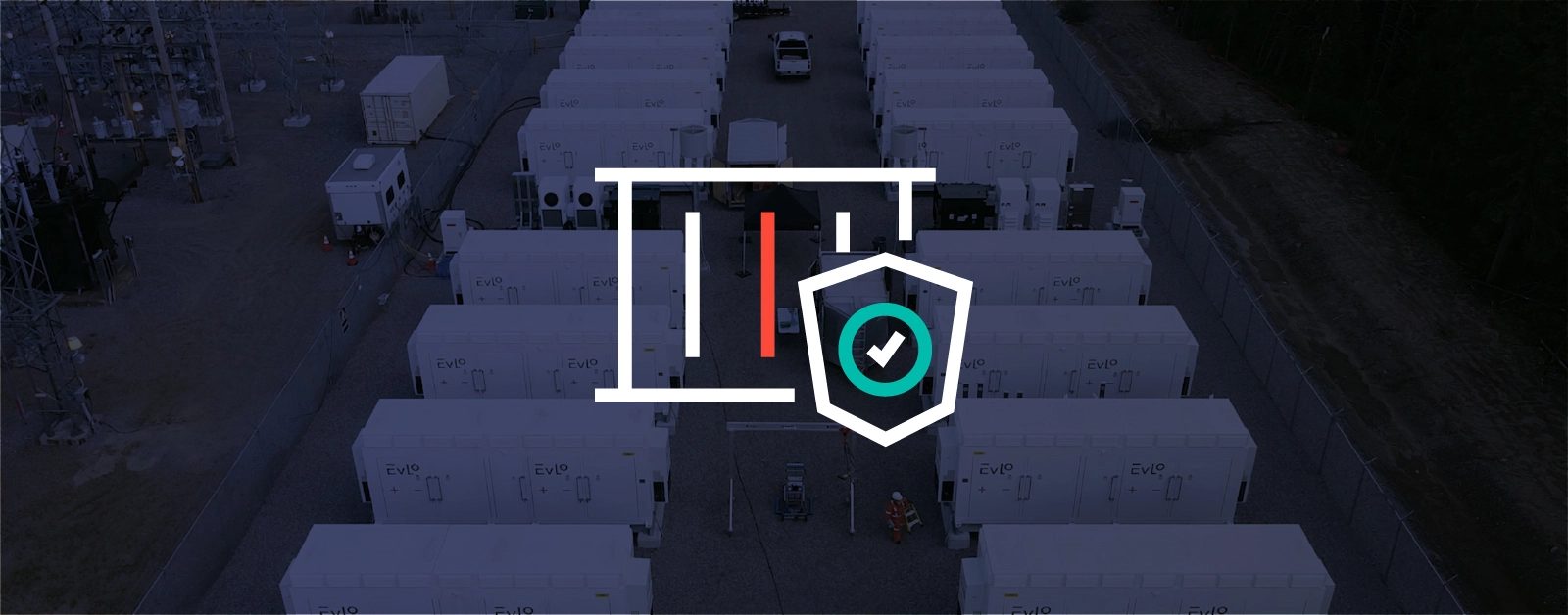Blog
Building a Better BESS: Safety Priorities for Battery Energy Storage Systems
February 1, 2024

Renewable energy sources like wind and solar are surging, with 36.4 GW of utility scale solar and 8.2 GW of wind expected to come online in 2024. To fully capitalize on the clean energy boom, utilities must capture and store excess energy to offset periods when the wind isn’t blowing and the sun isn’t shining, making battery energy storage systems (BESS) crucial to the grids of tomorrow.
The expected growth of grid-scale storage is raising questions about the safest ways to implement and optimize battery systems with existing energy infrastructure. Prioritizing safety in both design and installation, however, can help proactively mitigate potential concerns.
By making the right BESS safety decisions, utilities can accelerate grid decarbonization while reducing operational risk and safeguarding energy security. In partnership with Utility Dive, EVLO recently hosted a webinar providing an overview of the factors utilities should consider when planning for BESS safety.
Watch the recording here, or read on for a summary of what was covered.
Start With Design
Thermal runaway is the number one safety concern regarding batteries, as it can lead to fires if not addressed. It’s imperative that utilities ensure that their BESS suppliers take every precaution available to them and implement mitigations at all system levels, all the way from the chemistry to the BESS enclosure. Lithium iron phosphate (LFP) chemistry is more stable than other Lithium-ion chemistries, which translates into a lower likelihood of thermal runaway events. There should also be multiple levels of safeguards in case thermal runaway is initiated. EVLO’s newest and most advanced system — the EVLOFLEX — is equipped with safety features at every battery level, including the cell, module, rack, tray, and enclosure to protect against thermal runaway propagation.
Active and Passive Safety Measures
A comprehensive approach to BESS risk mitigation involves both active safety measures that work during regular operations and passive safety measures that kick in during system outages. Together, they provide continuous, long-term protection and containment. The NFPA 855 standard lays out requirements for large-scale fire testing and appropriate mitigation strategies for stationary storage, with Section 68 covering deflagration panels for the release of built up gasses and 69 covering active ventilation approaches. The EVLOFLEX combines active approaches outlined in section 69 with passive measures that will work even if not connected to auxillary power — an integrated approach that enhances overall BESS safety.
EVLOFLEX’s chimney design and vents are excellent examples of active safety measures helping prevent rising temperatures. Combined with a comprehensive monitoring system, the EVLOFLEX delivers robust fire protection that can be trusted regardless of the environment. We also offer additional safety measures, such as dry pipes, which allow first responders to pump water into the system from a safe distance in case of an incident.
Meeting and Surpassing Certifications
It’s essential that safety features are verified by industry-recognized certifications. As a leading BESS provider, EVLO meets and exceeds basic requirements, gaining additional expertise through supplementary and voluntary accreditation.
UL 9540 is one of the industry’s most important credentials for reputable BESS providers, as it establishes foundational safety standards, including battery capacity limits and separation distances. UL 9540A, a component of the UL 9540 certification, describes a test method to assess fire risks in particular. Additionally, Sections 68 & 69 of NFPA 855 provide guidance regarding BESS explosion protection (section 68) and prevention (section 69) measures, and NFPA 72 provides guidance for further fire, heat, and hydrogen safety testing. As mentioned earlier, EVLO’s BESS design goes beyond NFPA 69, and the company also chose to go beyond regular testing protocols by testing the entire system.
Trust but Verify
While a comprehensive approach and voluntary, third-party certification are strong indicators of BESS safety, utilities should always aim to verify system performance under real-world conditions. EVLO’s test line allows us to perform pre-installation testing while the BESS is connected to the grid, allowing utilities to verify performance under real-world conditions before delivery and with an unprecedented level of transparency. Here, we can further de-risk projects by demonstrating BESS resilience and proving viability under several conditions.
Utilities can also test for worst-case scenarios, allowing them to witness EVLOFLEX’s many safety features in action. As an added benefit, EVLO’s test line offers BESS training opportunities for utility staff and Authorities Having Jurisdiction (AHJs), helping drive new partnerships and elevating overall industry safety.
For more information on BESS safety and ensuring systems align with project needs of the future, watch the recording of our webinar with Utility Dive. Have questions about safety in your next BESS project? Get in touch with EVLO’s engineers and experts today!
